Lemon-Semolina Almond Cake
This post may contain affiliate links. Please read my disclosure policy.
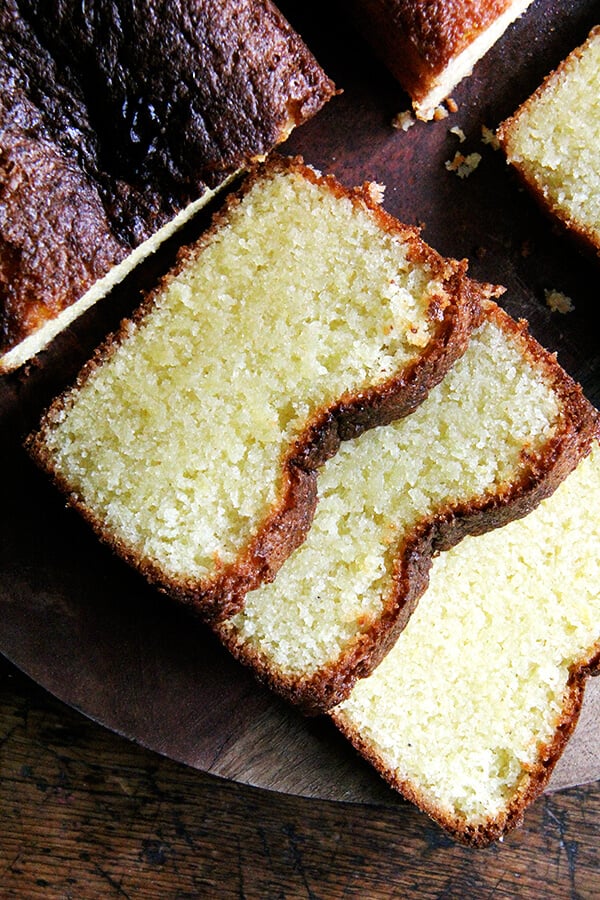
The April issue of Bon Appetit featured mini lemon-semolina syrup cakes, a recipe from Yotam Ottolenghi’s next cookbook, a dessert one, which is still in its recipe-testing phase. While I am not into mini anything right now — the less greasing/pan preparing the better — and while I don’t care for extra steps like syrup making (so lazy!), the ingredients for the cake looked so good: one half cup of semolina flour and lots of almond flour, butter, sugar, and fresh lemon juice.
I finally got around to making the cake last weekend using a loaf pan instead of a muffin tin, and, for whatever reason, replacing the butter with oil. Oh my. The cake was so incredibly moist — I know! Sorry. But there’s no other word, is there? — and delicious and perfectly sweet and lemony. For me, it doesn’t get much better than a lemon loaf cake, and this one is about as ideal as can be.
This past week I made it two more times, once with grapeseed oil and once with butter. I had no doubt I would prefer the cake made with oil — I often do — but with this one, I’m not sure. The differences are subtle. I ate and I ate and I ate hoping to discern a decisive winner until I discovered the good news: you can’t go wrong either way.
These are my observations: when the cake is made with oil, it will taste — wait for it — a little oily. When the cake is made with butter, it will taste richer and have a denser, more marzipan-like texture. Making the cake with oil allows you to whisk by hand, which is a little easier — no need to soften butter, no need to whip until light and fluffy. In a taste test with friends, more people preferred the cake made with oil, but for me, the one with butter has a slight edge.
Butter or oil? Something to ponder this weekend as you scour your cupboard for that half cup of semolina flour, because you know it’s there and what better way to use it up?
These are the dry ingredients: almond flour, semolina flour, baking powder, and salt:
This is what the batter looks like when made with butter:
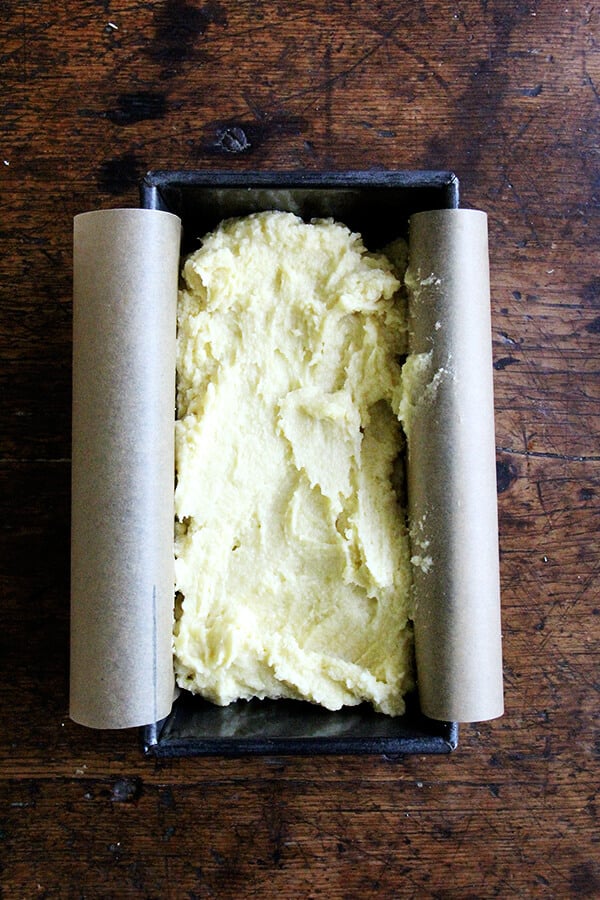
When made with oil:
The cake with the darker crust was made with oil:
This is the cake made with butter:
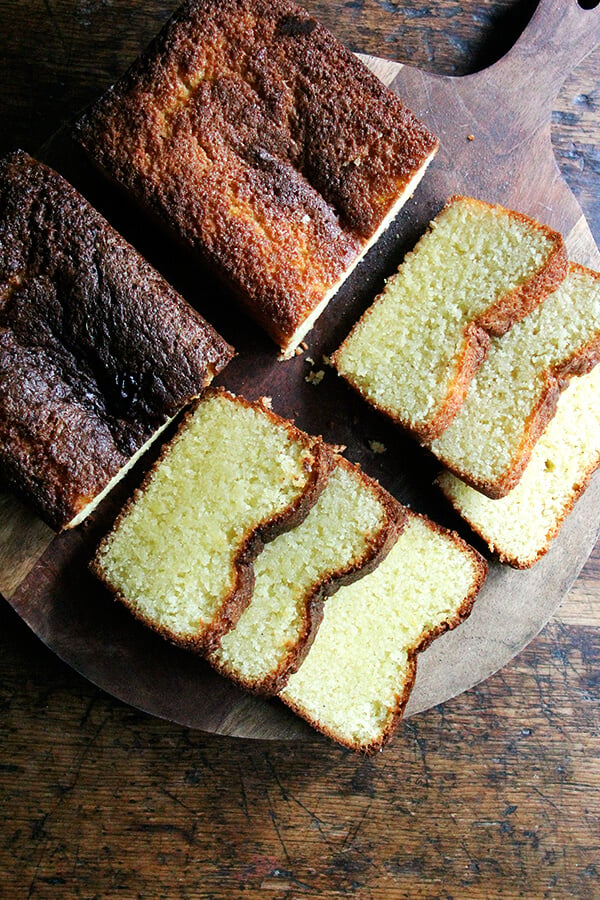

This one below is made with olive oil. Above left is made with grapeseed oil.

Lemon-Semolina Almond Cake
- Total Time: 1 hour 15 minutes
- Yield: 1 loaf
Description
Adapted from this Bon Appetit recipe
Check out the original recipe, which includes the addition of a syrup, but I don’t think the syrup is necessary — the cake is so delicious as is.
A few notes:
I increased the baking powder by ¼ teaspoon because I used a loaf pan. This might not be necessary if you use a muffin tin, as suggested in the original recipe. As noted in the post, I’ve made the cake three times now, once with butter, once with olive oil, and once with grapeseed oil. The difference is subtle: the oil makes the cake a little moister, the butter a little richer. Olive oil was preferable to grapeseed flavor-wise. In a tasted test with friends, the cake made with oil was preferable.
Ingredients
- 1½ cups (135 g) almond flour or almond meal
- ½ cup (79 g) semolina flour
- 1 teaspoon baking powder
- ½ teaspoon kosher salt
- ¾ cup (1½ sticks) unsalted butter, room temperature, or ¾ cup olive oil
- 1 cup plus 2 tablespoons (243 g) sugar
- 1 teaspoon finely grated lemon zest
- 3 large eggs, beaten to blend
- 2 tablespoons fresh lemon juice
Instructions
- Preheat oven to 350°F. Grease a loaf pan and line with parchment paper. Whisk together the almond flour, semolina flour, baking powder, and salt in a medium bowl to combine.
- Using an electric mixer on high speed, beat butter, sugar, and lemon zest until very light and fluffy, about 5 minutes. With motor running, gradually add eggs and beat until glossy, about 1 minute. Add dry ingredients and lemon juice and beat to combine, about 1 minute. (If you are using oil, simple whisk oil and sugar together. Add eggs one at a time, beating to incorporate, followed by dry ingredients and lemon juice.)
- Transfer batter to prepared loaf pan, and bake until golden brown, 50 to 60 minutes. Lightly press the top of the cake to test — it should feel lightly springy when done. Let cool 20 minutes or so in pan before removing and transferring to a cooling rack.
- Prep Time: 15 minutes
- Cook Time: 60 minutes
- Category: Quick Bread
- Method: Oven
- Cuisine: Middle Eastern
This post may contain affiliate links. Please read my disclosure policy.


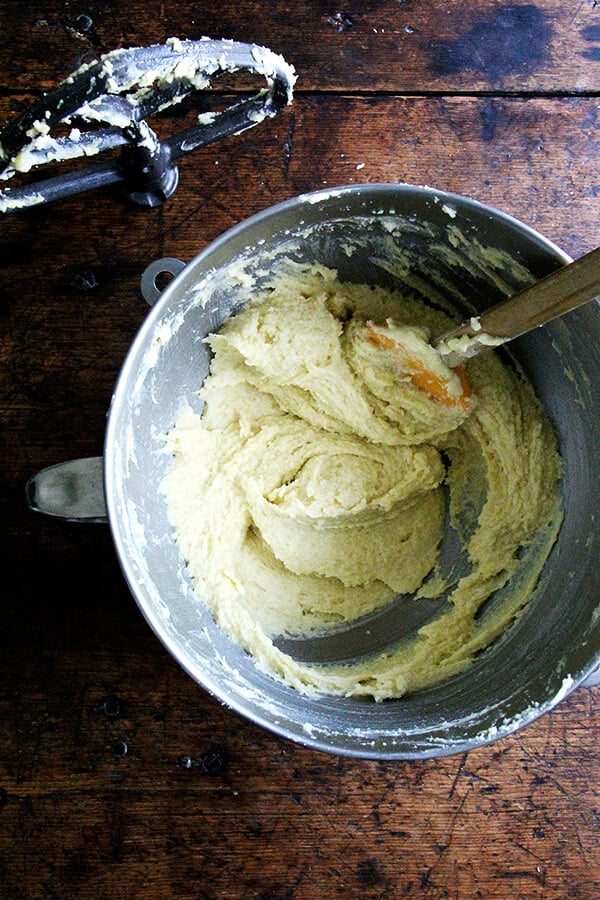
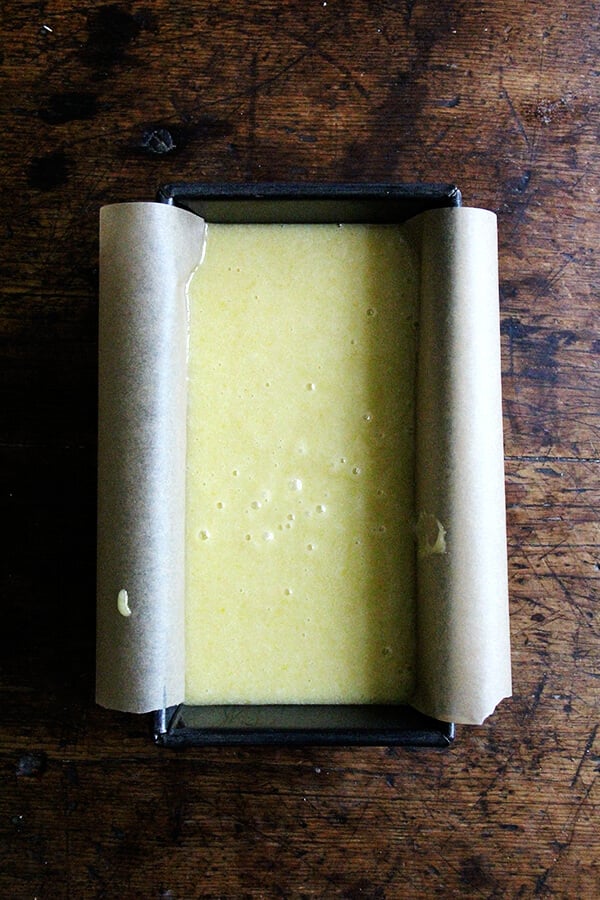
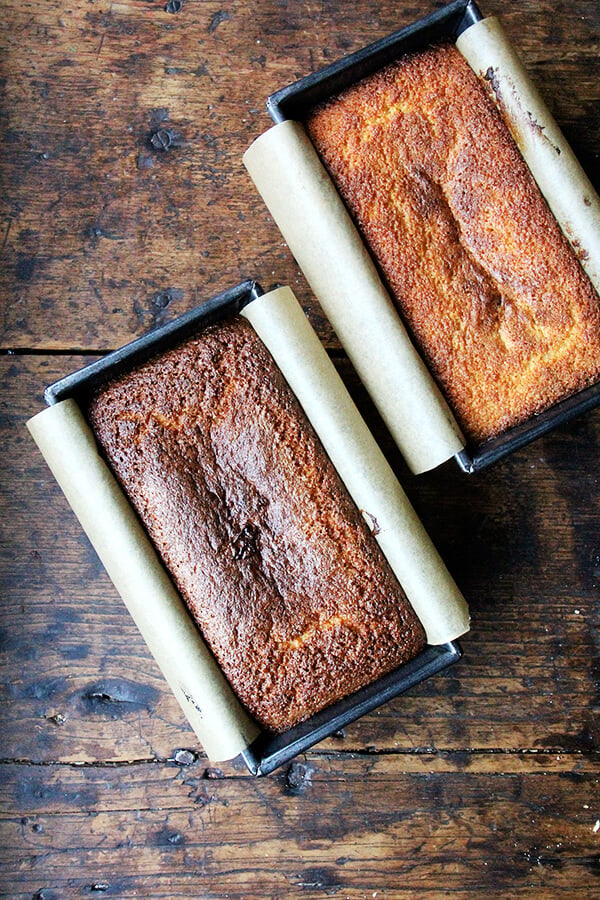
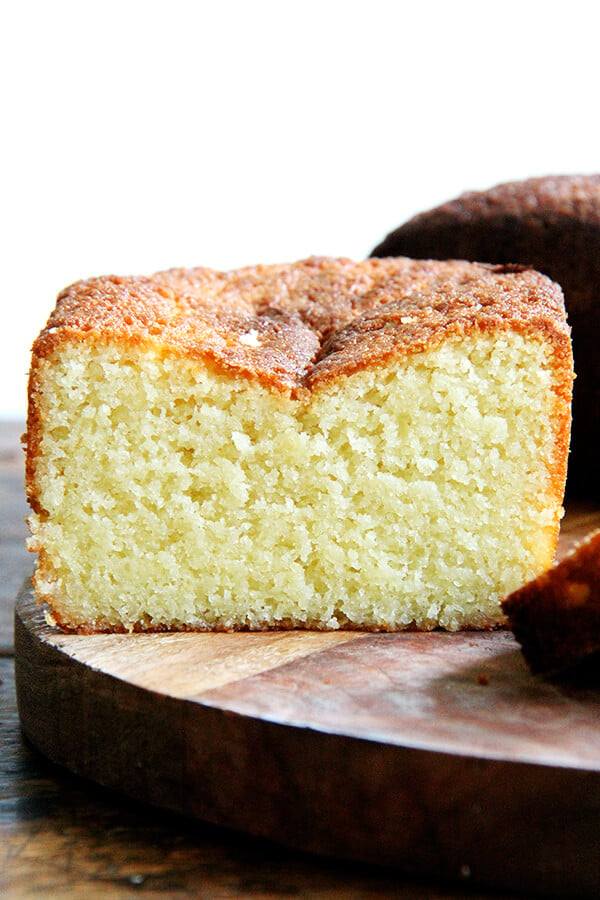






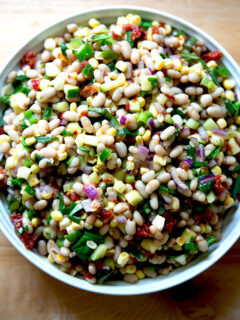




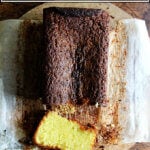
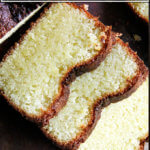
137 Comments on “Lemon-Semolina Almond Cake”
Great recipe! I sneak in some sourdough discard in mine, up the total lemon zest and juice and reduce total liquids. It lends more complexity to the cake which was a real treat.
Great to hear! Thanks so much for writing and sharing your notes 🙂 🙂 🙂
I’ve had the same problem twice now. I used the olive oil and mixed by hand. I didn’t use a scale but will try that next time. The cake is great though quit just looks deflated 🙁
Made this cake with butter a few days ago and it is dense and delicious! I did end up making the syrup too, and it really adds a beautiful lemony brightness. The only problem I had with my cake is that fell in the center A LOT, and I’m wondering whether all the mixing (7 minutes total!) made it rise too much and then fall? Anything else you can think of that I could do differently next time? Thanks, Ali!
Hi Christina! I do think over-mixing often is a reason for cakes to fall. More often these days, I opt to mix by hand, at least when incorporating eggs. I’m sorry to hear this! Only other thought is that the cake needs more flour. Are you using a scale to measure?
Hi Ali, I made this cake with olive oil, and swapped a number of ingredients- powdered sugar for granulated ones so i could mix by hand, n since I didn’t have real lemons on hand, I used 15 drops lemon essential oil, n I squeezed some of my frozen lemon pulp for juice n added some pulp to the batter as well. It turned out lovely, I’m gonna do this again.
Great to hear, Elinda! Thanks so much for writing and sharing your notes 🙂 🙂 🙂
I return to this recipe a lot! I often do ~half softened butter and half olive oil. It’s nice baked in a 9″ cake pan for quicker bake time and a different presentation for guests. Also less issue of it sinking in the middle like sometimes happens in a dense loaf pan. I add a tiny splash of Fior de Sicilia extract to boost the citrus intensity.
Oh yay! I haven’t made this one in years. Will revisit it soon. Thanks for writing 🙂
The bread came out super delicious! I swapped olive oil with canola oil, and added a bit more lemon zest and juice. Loved it!
Yum! Great to hear, Anu. Thanks for writing 🙂 🙂 🙂
Hi there Ali …
I hope the snow has stopped! I have friends not far from you in Syracuse.
I rounded up the organic almond flour, semolina, ground flaxseed, and coconut flour on the bottom shelf of my fridge then came here to find recipes to use up these pricey ingredients. Since I live alone & the kids are out of state, I don’t bake as much anymore.
Ali, you’re my first go-to when I have an urge to try something new. Tour Lemon-Semolina Almond Cake sounds just right for my first 2 ingredients. I’m nuts about lemon in anything & everything.
Now for the ground flaxseed & coconut flour. I’m hoping to find some healthy’ish baked snacks/bars to tuck into my school backpack. I started college again at 67! 😀
Cheers …
Anthea
Oh congratulations Anthea!!! That is so exciting.
I think you could use the ground flaxseed in these bars: https://alexandracooks.com/2022/10/15/no-bake-granola-bars-gluten-free-vegan/ (perfect for your school lunch :))
I think for the coconut flour I’d do what you’re doing with the pumpkin bread — try subbing in 1 cup of coconut flour there or in other quick bread recipes.
I messed up the recipe a little (made it with oil and completely forgot to incorporate the eggs before adding the flour) + very dodgily ground my own almond meal and still this cake is delicious! It didn’t rise as much as it should’ve + collapsed a bit in the middle given my mistakes, but it still resulted in a really good texture and is obviously a pretty foolproof recipe. Next time I might check out the syrup that BA recommend adding, but I agree that it’s definitely not a requirement for this to be delicious!!
So nice to read all of this, Ember! Thanks so much for writing and sharing your notes. This cake definitely does collapse a bit in the middle, so that might not have been a result of your slightly different process 🙂